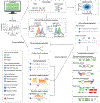Nanopore sequencing technology, bioinformatics and applications
- PMID: 34750572
- PMCID: PMC8988251
- DOI: 10.1038/s41587-021-01108-x
Nanopore sequencing technology, bioinformatics and applications
Abstract
Rapid advances in nanopore technologies for sequencing single long DNA and RNA molecules have led to substantial improvements in accuracy, read length and throughput. These breakthroughs have required extensive development of experimental and bioinformatics methods to fully exploit nanopore long reads for investigations of genomes, transcriptomes, epigenomes and epitranscriptomes. Nanopore sequencing is being applied in genome assembly, full-length transcript detection and base modification detection and in more specialized areas, such as rapid clinical diagnoses and outbreak surveillance. Many opportunities remain for improving data quality and analytical approaches through the development of new nanopores, base-calling methods and experimental protocols tailored to particular applications.
© 2021. Springer Nature America, Inc.
Conflict of interest statement
Competing interests
K.F.A. was invited by ONT to present at the conference London Calling 2020.
Figures





References
Publication types
MeSH terms
Grants and funding
LinkOut - more resources
Full Text Sources
Other Literature Sources

